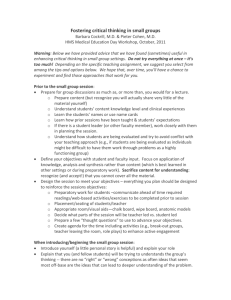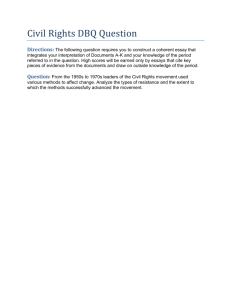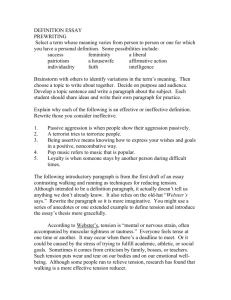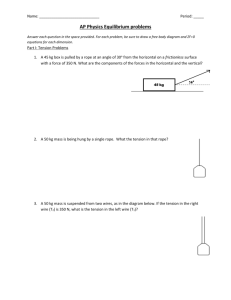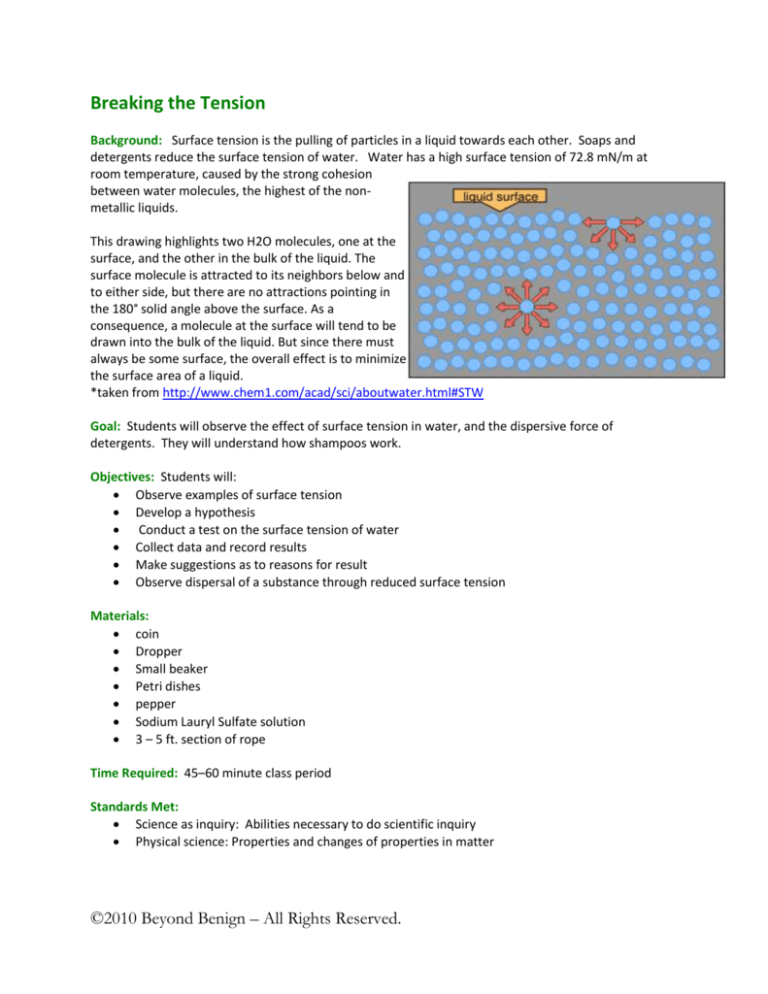
Breaking the Tension
Background: Surface tension is the pulling of particles in a liquid towards each other. Soaps and
detergents reduce the surface tension of water. Water has a high surface tension of 72.8 mN/m at
room temperature, caused by the strong cohesion
between water molecules, the highest of the nonmetallic liquids.
This drawing highlights two H2O molecules, one at the
surface, and the other in the bulk of the liquid. The
surface molecule is attracted to its neighbors below and
to either side, but there are no attractions pointing in
the 180° solid angle above the surface. As a
consequence, a molecule at the surface will tend to be
drawn into the bulk of the liquid. But since there must
always be some surface, the overall effect is to minimize
the surface area of a liquid.
*taken from http://www.chem1.com/acad/sci/aboutwater.html#STW
Goal: Students will observe the effect of surface tension in water, and the dispersive force of
detergents. They will understand how shampoos work.
Objectives: Students will:
Observe examples of surface tension
Develop a hypothesis
Conduct a test on the surface tension of water
Collect data and record results
Make suggestions as to reasons for result
Observe dispersal of a substance through reduced surface tension
Materials:
coin
Dropper
Small beaker
Petri dishes
pepper
Sodium Lauryl Sulfate solution
3 – 5 ft. section of rope
Time Required: 45–60 minute class period
Standards Met:
Science as inquiry: Abilities necessary to do scientific inquiry
Physical science: Properties and changes of properties in matter
©2010 Beyond Benign – All Rights Reserved.
Green Chemistry Principles Addressed:
Avoid using solvents, separation agents, or other auxiliary chemicals. If these chemicals are
necessary, use innocuous chemicals.
Procedure:
IN CLASS
Explain to students that liquids have a special property that keeps water particles sticking
together.
Ask students how many drops of water can be held on the coin before it runs off.
Explain the small experiment for the coin dropper test
Students conduct the dropper test and record results
Repeat test with few drops of Sodium Lauryl Sulfate solution added to beaker water
Write up results on board and make comparisons between groups’ results
Discuss variations of results
Explain surface tension as a result of the ways that the water molecules are attracted to each
other
o Have students stand in front of the room, holding the ends of a rope and leaning back
slightly to support each other’s weight.
o Explain that these students are representative of two water molecules attracting each
other. This attraction is called surface tension.
o Ask students what would happen if the attraction (rope) between these water
molecules (students) were broken.
Outline procedure for dispersal of pepper
Students conduct experiment and observe result.
Explain that substances used to break the surface tension of water are called surfactants.
Assessment:
Completed data table that accurately depicts the results of surface tension
Participation
Completed lab questions
Adhering to proper lab safety procedures
©2010 Beyond Benign – All Rights Reserved.
Breaking the Tension – Lab Procedures
1. Safety glasses MUST be worn during this lab
2. One member of your group should obtain your lab materials:
coin
Dropper
Small beaker of water
Large petri dish
Pepper shaker
Small beaker of SLS solution
3. Using a dropper, carefully add water drop by drop to the coin until water overflows. Count each
drop as you go!
4. Record the number of water droplets in the data table.
5. Repeat test using water from beaker with the SLS solution added to it.
6. Observe outcome.
7. Add water to petri dish.
8. Sprinkle pepper to cover the surface of the water
9. Add 1 drop of SLS solution to the water and record observations.
10. Clean up equipment according to teachers instructions
©2010 Beyond Benign – All Rights Reserved.
Breaking the tension - results
Group number
No of water drops held
(plain water)
No of water drops held
(water with SLS solution added)
Average
Breaking the tension – Lab Questions
1. How many drops of plain water could be held by the coins?
2. How many drops of water with SLS solution were held by the coins?
3. What was the effect of adding SLS solution to the pepper water?
4. One of the principles of green chemistry states:
Avoid using solvents, separation agents, or other auxiliary chemicals. If these chemicals are
necessary, use innocuous chemicals.
o
In this lab, what role does the SLS solution play?
o
List other ways to reduce surface tension in water?
©2010 Beyond Benign – All Rights Reserved.
Breaking the tension – Lab Questions Teacher Key
1. How many drops of plain water could be held by the coins?
Approximately 30-35 drops. Numbers will vary!
2. How many drops of water with SLS solution were held by the coins?
3. What was the effect of adding SLS solution to the pepper water?
The SLS broke the surface tension, allowing the pepper to disperse.
That’s way the pepper shot out of the sides of the petri dish.
4. One of the principles of green chemistry states:
Avoid using solvents, separation agents, or other auxiliary chemicals. If these
chemicals are necessary, use innocuous chemicals.
o In this lab, what role does the SLS solution play?
The SLS solution is a surfactant, an auxillary chemical. It serves to break the
surface tension of the water. As a cleansing agent, it is believed that this
allows the dirt or grease to be swept away. However, it may not be a
necessary chemical.
o
Surface
Temp.
tension
(°C)
(mN/m)
0
75.83
20
72.88
30
71.4
50
68.45
70
65.49
90
62.54
95
61.8
List other ways to reduce surface tension in water?
~ Heat reduces water tension (think of boiling water!) See chart above for specifics.
~ Gravity breaks water tension
~ Air breaks surface tension (often used for divers and ski jump training in a pool)
©2010 Beyond Benign – All Rights Reserved.


